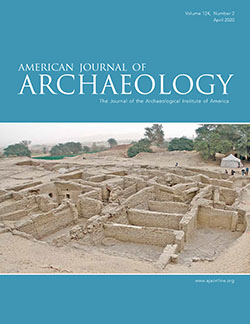AJA Open Access
BY-NCApril 2020 (124.2)
Book Review
Dura-Europos
By Jennifer A. Baird
Reviewed by Anna H. Walas
With the 100th anniversary of the European discovery of Dura-Europos approaching in 2020, the publication of Jennifer Baird’s latest synthesis of the site marks an important milestone in the scholarship on this ancient city. Published in Bloomsbury’s Archaeological Histories series, the book offers an accessible, up-to-date overview of the site, focusing particularly on the history of scholarship, the development of interpretations of the key categories of evidence, and the process of the production of archaeological knowledge. The long and complex history of work on Dura and the vast quantities of archaeological data produced have meant that large-scale attempts at synthesizing, reinterpreting, and presenting the site under a single narrative have been few. Monographs have tended to focus on the extensive catalogue of art from the site, the discovery of the site, or particular aspects of Dura’s architectural history, such as the author’s earlier monograph on the houses.
Baird has a long record of work on the archival material held at Yale University Art Gallery. Her participation in the French expedition carried out until 2011 provides her with an exceptional insight into both the archival and modern excavation material, which includes both the architecture and the finds assemblage. The book is structured from the point of view of the constituent parts of the archaeological record. The first chapter looks at the history of excavations at Dura-Europos with a particular focus on the work undertaken by Yale University between World War I and World War II. Baird investigates the context in which the excavations were undertaken, their public reception, and the team dynamics both in relation to gender and race, providing an interesting historiography of the problematic relationship between Western archaeologists and local populations. Chapter 2 synthesizes the history of the site from the little-known Hellenistic period to the Arsacid and Roman periods. The chapter pays particular attention to the context of the finds on which the dating of the discussed periods was based to warn against a false sense of certainty regarding the phasing of the site.
Chapter 3 develops Baird’s earlier work on the “archaeology of archives.” This is a particularly interesting chapter, as Baird brilliantly uses the example of Dura to discuss how the archaeology of a site is transformed in the process of its excavation, with archaeological field practices playing a pivotal role in shaping the subsequent interpretation of the site. Although Dura was the site of important battles, this is barely mentioned in historical sources. Instead, it is known almost exclusively through the site’s archaeology, making Dura-Europos an excellent object of such analysis. The chapter sets some of the key interpretative themes that surface through the book: the problematic relationship of the European excavators with the orientalizing sentiments of Westerners toward Dura, the perceived dichotomy between the “Greek” and local populations, and the debate regarding the cultural value of Dura.
Chapters 4 through 6 provide an account of the key sources of evidence: Dura’s texts, architecture, and material culture. Chapter 4 reviews the vast textual evidence, including the papyri, parchments, graffiti, and epigraphy, to investigate family, military, civilian, and religious relationships attested in the texts. A separate section deals with a selection of “difficult relationships” that showcase the evidence and presents a far more complicated image of Durene identities than the traditional dichotomy between Greek and local, with a multiplicity of languages, religions, and cultures, and with individuals often taking on multiple, contextual identities. Chapter 5 looks at the buildings in Dura, including houses, tombs, religious structures, public edifices, and military buildings. This chapter offers a useful overview of all structures excavated at Dura, but one of the more interesting sections is devoted to the study of the houses, Baird’s specialty. The author takes advantage of the remarkable opportunity to study the history of architectural changes made to specific houses in tandem with the papyri documenting ownership and the graffiti from their walls to show how the alterations to the buildings mirrored changes to family relationships as a result of deaths and marriages.
Chapter 6 examines the finds, including paintings, sculpture, pottery, coins, jewelery, textiles, lamps, metal, and glass. Baird draws attention to the distinction between the history of research on the much-celebrated sculpture and paintings and the treatment of bulk and small finds, which were not considered art and therefore not a priority. This led to many finds from the Yale excavations being improperly recorded, or even discarded without recording, particularly in the case of pottery. Baird’s presentation of the existing pottery assemblage provides interesting insights into the origin of particular vessel types, shedding light on the range of places from which people might have migrated into Dura and adding to her overall aim of presenting the site in its multicultural context. The author adds to the debate on Durene art by exploring potentially deliberate ambiguities in the most popular styles of sculpture.
This book offers a needed synthesis of a vast array of material and an accessible introduction to Dura’s complex history. Baird provides a reflection on the role of Dura in the construction of ideas about issues of mobility, ethnicity, and multicultural urban environments in antiquity. These themes chime with the politics of the past as an underlying component of the book, and the author’s self-reflection on the role of the current British political climate and its impact on her own approach. If there is anything to add, it perhaps would have been interesting to incorporate a fuller treatment of the French team’s results, particularly that of the magnetometry survey, to bring into the discussion the results of more recent fieldwork and the role of 21st-century archaeological methods in reconstructing Dura’s past.
Anna H. Walas
University of Leicester and University of Nottingham
ahw9@le.ac.uk
